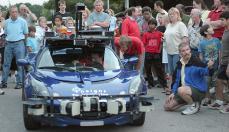One by one, a group of cars, trucks and SUVs lined up along the aptly named Starfighter Street in Victorville, Calif., early Saturday morning.
Each would soon take its turn driving across the starting line of the Defense Advanced Research Projects Agency’s Urban Challenge. And they would all do so completely unaided by a human driver.
But the long line of chutes that divided the parking lot looked a little barren as the 8 p.m. start time approached.
That’s because despite the 20 spots available in this year’s iteration of the race, only nine of the 35 semifinalists made it through last week’s final stages of qualifiers.
And N.C. State’s own Insight Racing team had been left behind.
A 60-mile course complete with 50-human vehicles, roundabouts and a slew of traffic signals, the DARPA Urban Challenge held a big reward for competitors who snagged the top spot — $2 million.
But Insight Racing team members learned Thursday morning that their entry, the Lone Wolf, wouldn’t get the chance to vie for the title.
“Going into Wednesday night, they had gradually told some teams they were out of the race,” said alumnus and team member Steve Kuekes, who spoke over the phone Tuesday on the return trip from California. “We hadn’t been told if we were out or in.”
The competition’s last qualifying event had led to several disqualifications, mostly due to collisions.
“We were told that if we hit another car, especially if it had a human driver, you were out,” he said.
At the end of the three-stage test, which ran the driverless cars through several real traffic scenarios, the field of 35 semifinalists was narrowed down to only 19.
“We thought that since they were planning to start 20 teams, that was good news,” Kuekes said.
The next morning however, DARPA officials announced they were cutting the field to 11, disqualifying Insight’s donated Lotus Elise from the competition.
Kuekes said the team was pleased with its progress, but was definitely dissapointed by the final result.
“It makes for a long trip back from California,” he said.
Although DARPA spokesperson Jan Walker didn’t say what specifically struck the Lone Wolf from the race, she said organizers lowered the number of participants based on the performances of the vehicles during the tests.
“We chose the number of vehicles that we thought could operate safely on the course,” Walker said.
She said judges were specifically looking to disqualify those robotic vehicles that didn’t follow traffic rules properly.
Team founder Grayson Randall said he wasn’t sure why the entry didn’t make the finals.
“It’s not clear to me why they made that decision,” Randall said. “We did not get any feedback as to why the decision was made.”
Kuekes said the Lone Wolf did well on two parts of the course, which required the vehicle to pull into moving traffic, find new routes through blocked roads and negotiate traffic-laden four-way stops. However the second portion, a long course through suburban streets with traffic and obstacles, “gave us some trouble.”
“The car had not run perfectly,” Kuekes said. “We felt like we were on the bubble there in the middle.”
Although Kuekes was also unsure what exactly disqualified the car from the race, some teams, like Georgia Tech, were struck for more obvious reasons.
“They had some big impacts with walls — some pretty spectacular impacts, apparently,” Kuekes said.
In the end, Tartan Racing from Pennsylvania, the Stanford Racing Team and Virginia Tech’s Victor Tango took home DARPA’s top prizes in the race.
All three teams had previously secured grants from DARPA, “to the tune of $1 million,” according to Kuekes. He said the three teams “were a cut above all the other teams that were out there.”
As for the future of Insight Racing, both Kuekes and Randall said they were a bit unsure how things would turn out.
“It’s too early to tell,” Randall said. “We haven’t had much time to think about it.”
Randall said after the team dismantles the Lone Wolf, it will return the Elise to Lotus. He said he’ll speak with the company to work on the final details.
Walker said that after three years of autonomous vehicle challenges, DARPA probably would not hold another competition in this area.
As for Kuekes, he said he plans to catch up on some fishing and repair work to his house, especially since he hasn’t had a free weekend in about nine months.
“We’re ready to take a little bit of a break,” he said.








